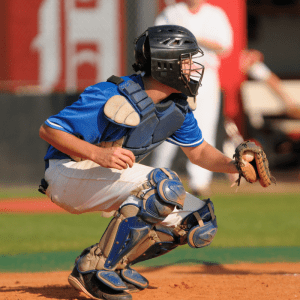Catcher’s Equipment
The catcher position in baseball and softball is considered one of the most demanding and difficult positions to play in the game. To play the position, a player needs to be knowledgeable in all facets of the sport and have the stamina and durability to catch endless games each season. In addition to the physical demands of the position, the player also needs to have the right equipment that will protect them from foul balls, home plate collisions, and the day-to-day grind of the position. This guide is designed to help players purchase the right catcher’s gear and covers the importance of the fit, the different types of masks, chest protectors, shin guards, and other gear that catchers need to play the position safely and effectively.
Correct Fit
The importance of fit when purchasing catcher’s gear cannot be neglected. A common mistake people make when purchasing catcher’s gear is buying gear that is too big with the idea that the player will grow into it. However, this can be problematic as it can cause the gear to move around during play and expose certain areas of the body that should be protected. Furthermore, larger pads can slow a catcher down when they need to jump quickly to throw a base runner out or run down the line to back up plays at first base. Many catchers also choose to mix and match brands of their gear as they get older, rather than buying a complete set of new gear, this allows them to replace only the specific gear they need. It is crucial to have the right gear that fits properly as it not only help you excel in the position but also keep you safe.
Catcher’s Masks
There are two types of catcher’s masks for players of all ages: the traditional two-piece mask and the modern hockey goalie style mask. While there isn’t a definitive “best” style, as with most gear, there are pros and cons to each, and mask style really depends on personal preference. The traditional two-piece masks are seen on players of all age ranges and are popular in large part because of their cost, they’re easier to throw off for foul balls, plays at the plate, and other dire moments, and they provide more ventilation than the hockey style mask, which helps keep you cooler during long, hot summer games. However, traditional masks also have some drawbacks, including that they don’t provide nearly as much protection as hockey style masks, particularly around the ears. On the other hand, hockey style masks have become increasingly popular in recent years, especially in the major leagues, as they provide more protection, better vision and comfort, but the hockey style mask can be bulkier and heavier than traditional one. It’s important to note that traditional masks are outlawed in some leagues, so be sure to check your league rules before you decide on the type of mask you’ll invest in.
Chest Protestors
There are two main types of chest protectors: foam and plastic. Each type has its own set of pros and cons. Foam chest protectors are known for their flexibility, lightweight, and they are less expensive. However, they also provide less protection than plastic chest protectors. On the other hand, plastic chest protectors are more durable, provide more protection and they are better at absorbing impact, but they tend to be heavier and more expensive. It’s important to consider your personal preference and budget when choosing a chest protector, but also remember that the most important factor is the protection it provides.
Shin Guards
Like chest protectors, shin guards come in two main types: foam and plastic. Foam shin guards are known for their flexibility and lightweight. They are also less expensive than plastic shin guards. However, they also provide less protection than plastic shin guards. On the other hand, plastic shin guards are more durable and provide more protection but they tend to be heavier and more expensive. It’s important to consider your personal preference and budget when choosing shin guards, but also remember that the most important factor is the protection they provide. It’s also worth noting that some leagues might have specific rules about shin guards, so be sure to check your league rules before purchasing.
Additional Gear/Protection
Some of the additional gear that catchers may need include gloves, knee savers, throat guard, and a cup. Gloves are a must-have for any catcher as they offer protection for the hands and fingers from foul balls and other impacts, as well as improving your grip. Knee savers are a type of pad that attaches to the leg guard and helps to reduce the stress on the catcher’s knees. Throat guards are worn under the mask and provide protection for the neck and throat from foul tips or backswings. And a cup is worn to protect the groin area (self explanatory). It’s important to consider your own needs and preferences when choosing these additional gear, but always remember to prioritize safety over anything else.
Conclusion
It’s important to remember that purchasing the right gear is essential for both the performance and safety of the catcher. The guide provides an overview of the different types of gear available, and the pros and cons of each type. It’s important to consider your personal preference, budget, and league rules when purchasing gear. Having the right gear will not only help you excel in the position but also keep you safe.
